from IPython.display import Image
%matplotlib inline
# Added version check for recent scikit-learn 0.18 checks
from distutils.version import LooseVersion as Version
from sklearn import __version__ as sklearn_version处理缺省值
import pandas as pd
from io import StringIO
csv_data = '''A,B,C,D
1.0,2.0,3.0,4.0
5.0,6.0,,8.0
10.0,11.0,12.0,'''
print(type(csv_data))
# If you are using Python 2.7, you need to convert the string to unicode:
#csv_data = unicode(csv_data)
df = pd.read_csv(StringIO(csv_data))
#StringIO的行为与file对象非常像,但它不是磁盘上文件,而是一个内存里的“文件”,可以将操作磁盘文件那样来操作StringIO
#StringIO在内存中读写str,要想把str写入StringIO:先创建一个StringIO,然后像文件一样写入即可
df
#type(df) #pandas.core.frame.DataFrame
df.isnull().sum() #isnull判定每个位置是否是NaN,计算每一特征中:有几个样本在该特征上存在缺失
#Output:
#A 0
#B 0
#C 1
#D 1
#dtype: int641.)直接删除缺省值多的样本或者特征
df.dropna() #删存在缺省值的样本
df.dropna(axis=1) #删存在缺省值的特征
df.dropna(how='all') #删所以特征都缺失的样本
df.dropna(thresh=4) #删特征数少于参数指定个数的样本
df.dropna(subset=['C']) #删在指定特征处有缺失的样本
2.)重新计算缺省值
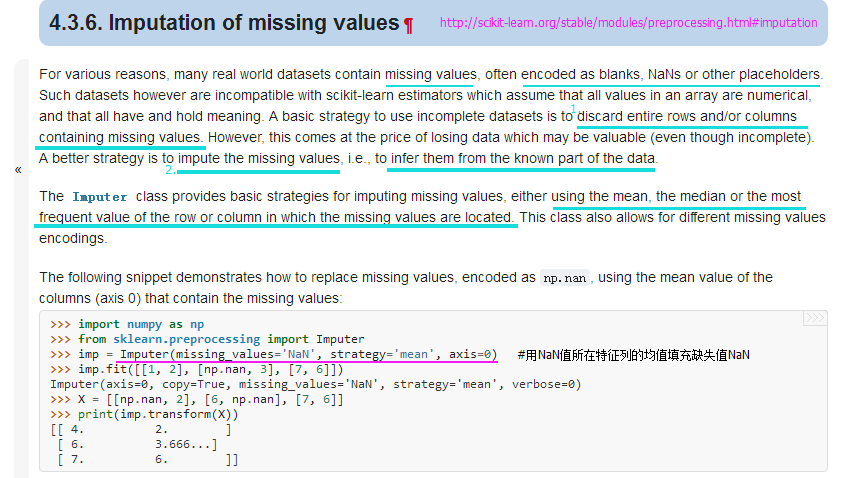
from sklearn.preprocessing import Imputer
#http://scikit-learn.org/stable/modules/generated/sklearn.preprocessing.Imputer.html#sklearn.preprocessing.Imputer
imr = Imputer(missing_values='NaN', strategy='mean', axis=0) #用NaN所在特征列的均值填充NaN
imr = imr.fit(df)
imputed_data = imr.transform(df.values)
imputed_data
#Output:
#array([[ 1. , 2. , 3. , 4. ],
# [ 5. , 6. , 7.5, 8. ],
# [ 10. , 11. , 12. , 6. ]])df.values
#Output:
#array([[ 1., 2., 3., 4.],
# [ 5., 6., nan, 8.],
# [ 10., 11., 12., nan]])处理类别型数据
import pandas as pd
df = pd.DataFrame([['green', 'M', 10.1, 'class1'],
['red', 'L', 13.5, 'class2'],
['blue', 'XL', 15.3, 'class1']])
df.columns = ['color', 'size', 'price', 'classlabel']
df
1.)序列特征映射
size_mapping = {'XL': 3,'L': 2,'M': 1}
df['size'] = df['size'].map(size_mapping) #将size特征列的XL等字符替换成字典size_mapping映射对应的数字
df
inv_size_mapping = {v: k for k, v in size_mapping.items()}
#字典推导式,items()是将字典中键值转化成元组对,整体以列表返回
#size_mapping.items():dict_items([('XL', 3), ('L', 2), ('M', 1)])
df['size'].map(inv_size_mapping)
#Output:
#0 M
#1 L
#2 XL
#Name: size, dtype: object2.)类别编码
import numpy as np
class_mapping = {label: idx for idx, label in enumerate(np.unique(df['classlabel']))}
#enumerate将列表参数映射成带序号的元组对
#class_mapping作用是找出出现一个新classlabel时对应的index
class_mapping
#Output:
#{'class1': 0, 'class2': 1}df['classlabel'] = df['classlabel'].map(class_mapping)
df
inv_class_mapping = {v: k for k, v in class_mapping.items()}
df['classlabel'] = df['classlabel'].map(inv_class_mapping)
df
from sklearn.preprocessing import LabelEncoder
#http://scikit-learn.org/stable/modules/preprocessing_targets.html#preprocessing-targets
class_le = LabelEncoder()
y = class_le.fit_transform(df['classlabel'].values)
y
#Output:
#array([0, 1, 0], dtype=int64)class_le.inverse_transform(y)
#Output:
#array(['class1', 'class2', 'class1'], dtype=object)3.)对类别型的特征用one-hot编码
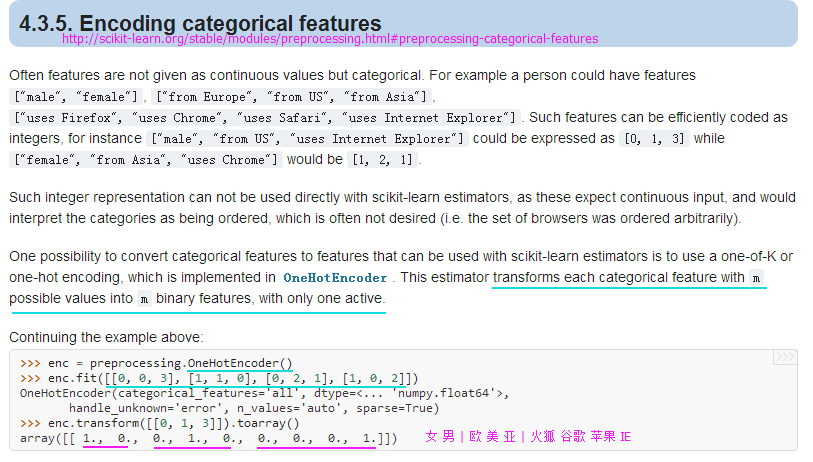
X = df[['color', 'size', 'price']].values
from sklearn.preprocessing import LabelEncoder
color_le = LabelEncoder()
X[:, 0] = color_le.fit_transform(X[:, 0]) #对color特征列进行顺序出现编码
X
#Output:
#array([[1, 1, 10.1],
# [2, 2, 13.5],
# [0, 3, 15.3]], dtype=object)#检验color特征列编码序号原理,对应df结构看
from sklearn.preprocessing import LabelEncoder
color_le = LabelEncoder()
color_le.fit(df['color'])
#Output:
#array(['blue', 'green', 'red'], dtype=object)
color_le.classes_from sklearn.preprocessing import OneHotEncoder
#http://scikit-learn.org/stable/modules/generated/sklearn.preprocessing.OneHotEncoder.html#sklearn.preprocessing.OneHotEncoder
ohe = OneHotEncoder(categorical_features=[0]) #categorical_features参数指定独热特征列
ohe.fit_transform(X).toarray()
#Output:
#array([[ 0. , 1. , 0. , 1. , 10.1],
# [ 0. , 0. , 1. , 2. , 13.5],
# [ 1. , 0. , 0. , 3. , 15.3]])pd.get_dummies(df[['price', 'color', 'size']]) #pandas内的独热方法get_dummies()
切分数据集(训练集与测试集)
df_wine = pd.read_csv('https://archive.ics.uci.edu/ml/machine-learning-databases/wine/wine.data',header=None)
df_wine.columns = ['Class label', 'Alcohol', 'Malic acid', 'Ash',
'Alcalinity of ash', 'Magnesium', 'Total phenols',
'Flavanoids', 'Nonflavanoid phenols', 'Proanthocyanins',
'Color intensity', 'Hue', 'OD280/OD315 of diluted wines',
'Proline']
print('Class labels', np.unique(df_wine['Class label']))
#df_wine.to_csv('wine.csv')
df_wine.head()
#Output:
#Class labels [1 2 3]
if Version(sklearn_version) < '0.18':
from sklearn.cross_validation import train_test_split
else:
from sklearn.model_selection import train_test_split
X, y = df_wine.iloc[:, 1:].values, df_wine.iloc[:, 0].values #df_wine数据的第一列作为标签类别,其余列作为特征
X_train, X_test, y_train, y_test = train_test_split(X, y, test_size=0.3, random_state=0) #全部数据的30%作为测试集对连续值特征做幅度缩放(scaling)
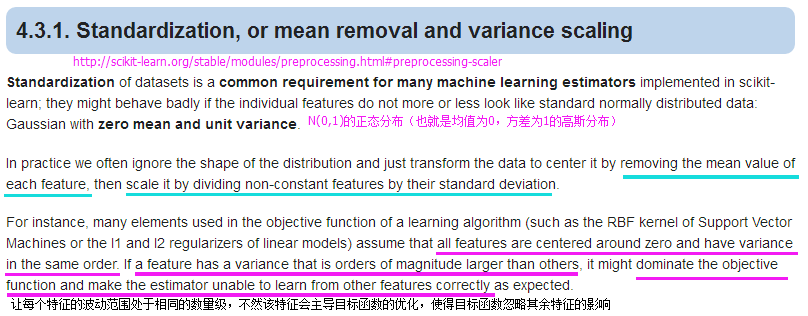
from sklearn.preprocessing import MinMaxScaler
#http://scikit-learn.org/stable/modules/generated/sklearn.preprocessing.MinMaxScaler.html#sklearn.preprocessing.MinMaxScaler
#U(0,1)区间[0,1]上的均匀分布缩放,按单个特征列看
mms = MinMaxScaler()
X_train_norm = mms.fit_transform(X_train)
X_test_norm = mms.transform(X_test)
from sklearn.preprocessing import StandardScaler
#N(0,1)正态分布缩放
stdsc = StandardScaler()
X_train_std = stdsc.fit_transform(X_train)
X_test_std = stdsc.transform(X_test)特征选择
1.) 通过L1正则化的截断型效应选择
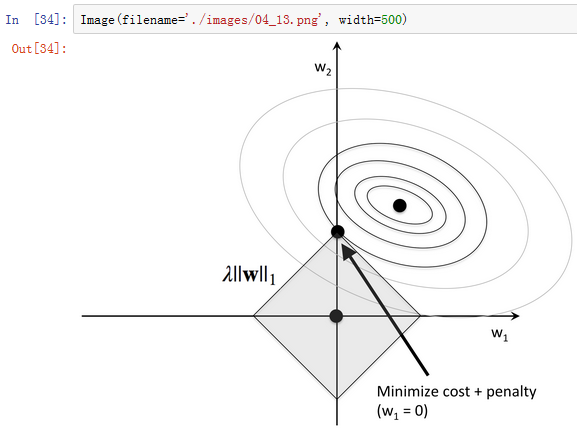
from sklearn.linear_model import LogisticRegression
lr = LogisticRegression(penalty='l1', C=0.1)
lr.fit(X_train_std, y_train)
print('Training accuracy:', lr.score(X_train_std, y_train))
print('Test accuracy:', lr.score(X_test_std, y_test))
#Output:
#Training accuracy: 0.983870967742
#Test accuracy: 0.981481481481
lr.intercept_
#Output:
#array([-0.38380842, -0.15812178, -0.70041244])lr.coef_
#Output:
#array([[ 0.28025703, 0. , 0. , -0.02792998, 0. ,
# 0. , 0.71008021, 0. , 0. , 0. ,
# 0. , 0. , 1.23625518],
# [-0.64387692, -0.06882766, -0.05718195, 0. , 0. ,
# 0. , 0. , 0. , 0. , -0.92717674,
# 0.05982319, 0. , -0.37086571],
# [ 0. , 0.06151692, 0. , 0. , 0. ,
# 0. , -0.63612079, 0. , 0. , 0.49812314,
# -0.35823174, -0.57118053, 0. ]])import matplotlib.pyplot as plt
fig = plt.figure()
ax = plt.subplot(111)
colors = ['blue', 'green', 'red', 'cyan', 'magenta', 'yellow', 'black',
'pink', 'lightgreen', 'lightblue', 'gray', 'indigo', 'orange']
weights, params = [], []
for c in range(-4, 6):
lr = LogisticRegression(penalty='l1', C=10**c, random_state=0)
lr.fit(X_train_std, y_train)
weights.append(lr.coef_[1])
params.append(10**c)
weights = np.array(weights) #10*13的数组
for column, color in zip(range(weights.shape[1]), colors):
plt.plot(params, weights[:, column], label=df_wine.columns[column + 1], color=color)
#column+1去掉第一列label列
plt.axhline(0, color='black', linestyle='--', linewidth=1)
plt.xlim([10**(-5), 10**5])
plt.ylabel('weight coefficient')
plt.xlabel('C')
plt.xscale('log')
plt.legend(loc='upper left')
ax.legend(loc='upper center', bbox_to_anchor=(1.38, 1.03), ncol=1, fancybox=True)
# plt.savefig('./figures/l1_path.png', dpi=300)
plt.show()2.) 遍历子特征集选择法
from sklearn.base import clone
from itertools import combinations
import numpy as np
from sklearn.metrics import accuracy_score
#http://scikit-learn.org/stable/modules/generated/sklearn.metrics.accuracy_score.html#sklearn.metrics.accuracy_score
if Version(sklearn_version) < '0.18':
from sklearn.cross_validation import train_test_split
else:
from sklearn.model_selection import train_test_split
class SBS():
def __init__(self, estimator, k_features, scoring=accuracy_score, test_size=0.25, random_state=1):
self.scoring = scoring
self.estimator = clone(estimator) #构造一个具有相同参数的估计器
#http://scikit-learn.org/stable/modules/generated/sklearn.base.clone.html#sklearn.base.clone
self.k_features = k_features
self.test_size = test_size
self.random_state = random_state
def fit(self, X, y):
X_train, X_test, y_train, y_test = train_test_split(X, y, test_size=self.test_size, random_state=self.random_state)
dim = X_train.shape[1] #13
self.indices_ = tuple(range(dim)) #(0,1,2,...,12)
self.subsets_ = [self.indices_]
score = self._calc_score(X_train, y_train, X_test, y_test, self.indices_) #全特征组合得分
self.scores_ = [score]
while dim > self.k_features: #至少要考虑到k_features个特征
scores = []
subsets = []
for p in combinations(self.indices_, r=dim - 1): #combinations求组合,不取全部13个特征:每次只取12个特征,11个特征...
score = self._calc_score(X_train, y_train, X_test, y_test, p)
scores.append(score)
subsets.append(p)
best = np.argmax(scores) #argmax求分数最高的特征组合所在的索引
self.indices_ = subsets[best] #根据索引,取分数最高特征组合
self.subsets_.append(self.indices_) #同个数特征的各个组合中,得分最高的组合构成的列表
dim -= 1
self.scores_.append(scores[best]) #同个数特征的各个组合中,最优特征组合的得分构成的列表
self.k_score_ = self.scores_[-1] #每k个特征组合的最好得分,直接取scores_列表中最好加入的元素
return self
def transform(self, X):
return X[:, self.indices_]
def _calc_score(self, X_train, y_train, X_test, y_test, indices):
self.estimator.fit(X_train[:, indices], y_train)
y_pred = self.estimator.predict(X_test[:, indices])
score = self.scoring(y_test, y_pred) #用accuracy_score方法计算
return score
#indices_是每个维度最优特征组合元组,subsets_是包含各个维度最优特征组合元组的列表,scores_是包含各个维度最优特征组合得分的列表import matplotlib.pyplot as plt
from sklearn.neighbors import KNeighborsClassifier
knn = KNeighborsClassifier(n_neighbors=2)
# selecting features
sbs = SBS(knn, k_features=1)
sbs.fit(X_train_std, y_train)
# plotting performance of feature subsets
k_feat = [len(k) for k in sbs.subsets_]
plt.plot(k_feat, sbs.scores_, marker='o')
plt.ylim([0.7, 1.1])
plt.ylabel('Accuracy')
plt.xlabel('Number of features')
plt.grid()
plt.tight_layout()
# plt.savefig('./sbs.png', dpi=300)
plt.show()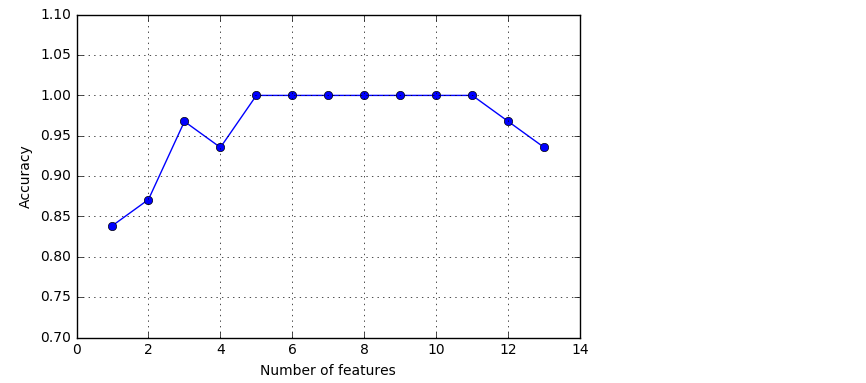
k5 = list(sbs.subsets_[8])
print(df_wine.columns[1:][k5]) #去除第一个标签列计数
#Output:
#Index(['Alcohol', 'Malic acid', 'Alcalinity of ash', 'Hue', 'Proline'], dtype='object')
knn.fit(X_train_std, y_train) #全部特征建模得分
print('Training accuracy:', knn.score(X_train_std, y_train))
print('Test accuracy:', knn.score(X_test_std, y_test))
#Output:
#Training accuracy: 0.983870967742
#Test accuracy: 0.944444444444knn.fit(X_train_std[:, k5], y_train) #只选k5组合包含的特征建模得分
print('Training accuracy:', knn.score(X_train_std[:, k5], y_train))
print('Test accuracy:', knn.score(X_test_std[:, k5], y_test))
#Output:
#Training accuracy: 0.959677419355
#Test accuracy: 0.9629629629633.) 通过随机森林对特征重要性排序
from sklearn.ensemble import RandomForestClassifier
feat_labels = df_wine.columns[1:] #特征列名
forest = RandomForestClassifier(n_estimators=2000, random_state=0, n_jobs=-1) #2000棵树,并行工作数是运行服务器决定
forest.fit(X_train, y_train)
importances = forest.feature_importances_ #feature_importances_特征列重要性占比
indices = np.argsort(importances)[::-1] #对参数从小到大排序的索引序号取逆,即最重要特征索引——>最不重要特征索引
for f in range(X_train.shape[1]):
print("%2d) %-*s %f" % (f + 1, 30, feat_labels[indices[f]], importances[indices[f]]))
#-*s表示左对齐字段feat_labels[indices[f]]宽为30
plt.title('Feature Importances')
plt.bar(range(X_train.shape[1]), importances[indices], color='lightblue', align='center')
plt.xticks(range(X_train.shape[1]), feat_labels[indices], rotation=90)
plt.xlim([-1, X_train.shape[1]])
plt.tight_layout()
#plt.savefig('./random_forest.png', dpi=300)
plt.show()
#Output:
# 1) Color intensity 0.183084
# 2) Proline 0.163305
# 3) Flavanoids 0.152030
# 4) OD280/OD315 of diluted wines 0.133887
# 5) Alcohol 0.103847
# 6) Hue 0.077784
# 7) Total phenols 0.058778
# 8) Alcalinity of ash 0.031300
# 9) Malic acid 0.024420
#10) Magnesium 0.021949
#11) Proanthocyanins 0.021870
#12) Nonflavanoid phenols 0.014450
#13) Ash 0.013294
if Version(sklearn_version) < '0.18':
X_selected = forest.transform(X_train, threshold=0.15)
else:
from sklearn.feature_selection import SelectFromModel
sfm = SelectFromModel(forest, threshold=0.15, prefit=True)
#forest参数是建模完带特征重要性信息的估计器,threshold是特征筛选阈值
X_selected = sfm.transform(X_train) #transform对样本X_train进行了选定特征列过滤
X_selected.shape
#Output:
#(124, 3)for f in range(X_selected.shape[1]):
print("%2d) %-*s %f" % (f + 1, 30, feat_labels[indices[f]], importances[indices[f]]))
#Output:
# 1) Color intensity 0.183084
# 2) Proline 0.163305
# 3) Flavanoids 0.152030








 本文介绍了使用Python和scikit-learn进行数据预处理的方法,包括处理缺失值、类别型数据编码、数据集划分及特征缩放等。此外,还探讨了三种特征选择方法:L1正则化截断型效应选择、遍历子特征集选择法和随机森林特征重要性排序。
本文介绍了使用Python和scikit-learn进行数据预处理的方法,包括处理缺失值、类别型数据编码、数据集划分及特征缩放等。此外,还探讨了三种特征选择方法:L1正则化截断型效应选择、遍历子特征集选择法和随机森林特征重要性排序。

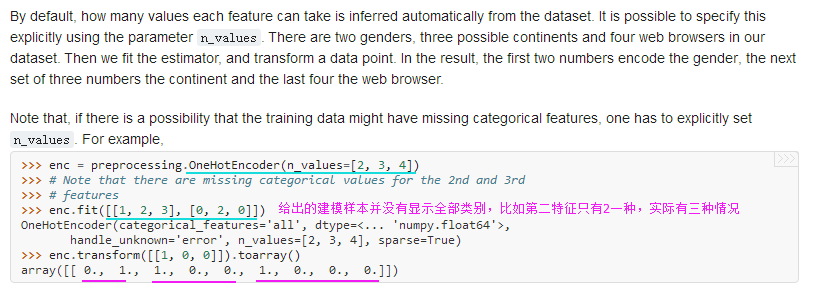
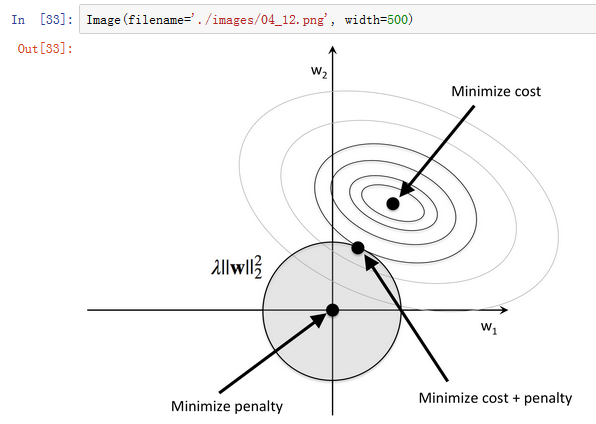
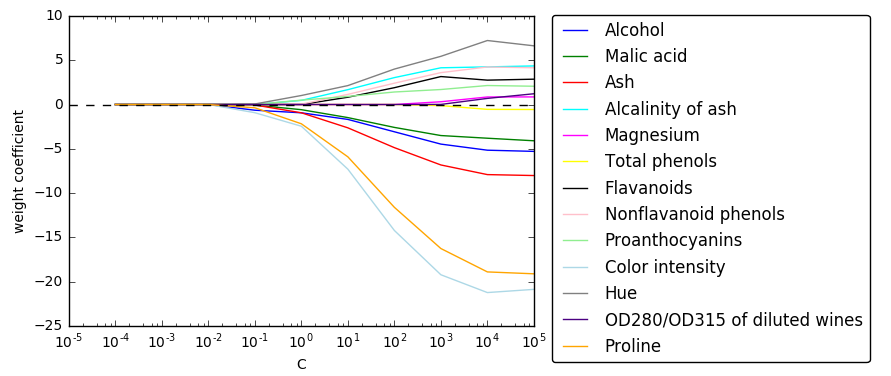
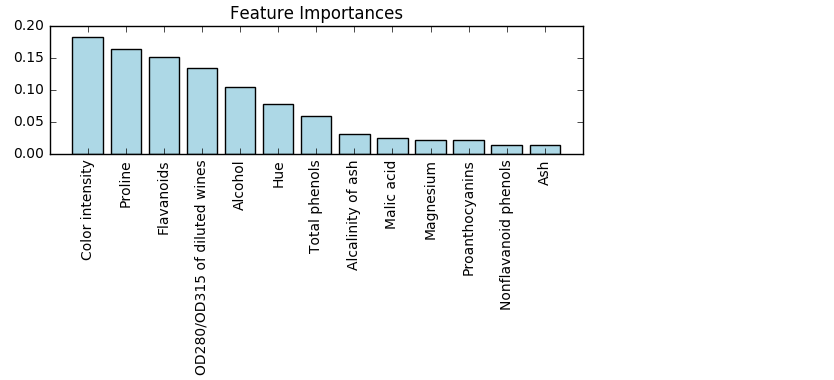














 1万+
1万+

 被折叠的 条评论
为什么被折叠?
被折叠的 条评论
为什么被折叠?








